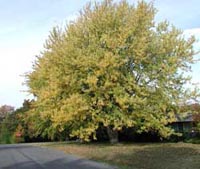Resource Library
Plant of the Week: Silver Maple
The University of Arkansas System Division of Agriculture does not promote, support or recommend plants featured in "Plant of the Week." Please consult your local Extension office for plants suitable for your region.
Plant of the Week
Silver Maple
Latin: Acer saccharinum

The most important decision we face when designing a landscape is our choice of trees. If we choose poorly, our planting will be plagued with this faulty choice for years to come and the grand scheme we see in our mind's eye will never be realized.
Yet, we are mortal creatures prone to impatience. We want to see things grow and develop. Surely this impatience is what keeps people planting silver maples, a tree that - despite its many faults - is the twentieth most commonly planted shade tree in American gardens.
Silver maples (Acer saccharinum) are big, fast growing trees capable of reaching 80 feet in height with a spread almost equal their height. They are not orderly trees with symmetrical form; every bud seems to seek a leadership role in growth, resulting in trees that branch low to the ground and produce an abundance of long, wispy branches. These branches are often overly long for their diameter and overly brittle, making them prone to breakage during wind and ice storms.
The silver maple leaf is a long-petioled affair with the blade three to five inches long and wide. It is 5-lobed with each lobe dissected with varying degrees of jagged and deep serrations. During the summer the slightest puff of breeze causes leaves to flash their silver underbellies like a school of shiners in a shallow stream. Fall color is yellow but its fall display is frequently mediocre.
Female trees produce clusters of red flowers along the stem in late winter that are an early signal of the coming spring. The seeds mature in May and germinate immediately if given a moist location. An undocumented and unappreciated role the silver maple plays is in introducing our nation's children to the joys of nature. Because it is so widely grown across the country, surely no other tree has entertained and delighted more children with it's helicopter-like seeds on a bright May morning. Perhaps the next Thoreau or Carson will be awakened to the joys of nature by the whirl of the samaras as they spiral towards the ground.
Americans are always in a rush so not surprisingly there is a strong demand for fast growing trees to provide quick shade. For the past 30 years I've watched a shade tree planting grow from saplings to mature trees. During the first 15 years the silver maple outgrew its competitors and was about five feet taller than its rivals, but with its typical unruly form. But by the 20th year, the oaks had overtaken it in size and far exceeded it in grandeur. Around its 25th year an ice storm swept in and stripped it of its limbs and it was removed, while its stouter silvan cousins survived with little damage.
Most trees in our landscapes and park plantings should be those with the promise of outliving us. But don't be too quick to dismiss these fast growers - the silver maples, the Bradford pears, the willows - for they give immediate effect and can provide the early framework for our gardens. They also make it possible - and necessary for that matter - to redesign the landscape after a few years to correct the mistakes we made the first time around.
The silver maple is an adaptable grower that thrives in a wide array of conditions, growing about as well on mine reclamation sites as in good garden soils. Like most big trees, it should have at least six hours of sunlight, but otherwise will grow almost as successfully on mine spoils as garden soils. Once established it has good drought tolerance, but the tactic it uses to achieve this trait is to drop its inner leaves as drought stress worsens. Like most maples it is shallow rooted, making it difficult to grow other plants beneath it.
By: Gerald Klingaman, retired
Extension Horticulturist - Ornamentals
Extension News - April 11, 2003
The University of Arkansas System Division of Agriculture does not maintain lists of retail outlets where these plants can be purchased. Please check your local nursery or other retail outlets to ask about the availability of these plants for your growing area.